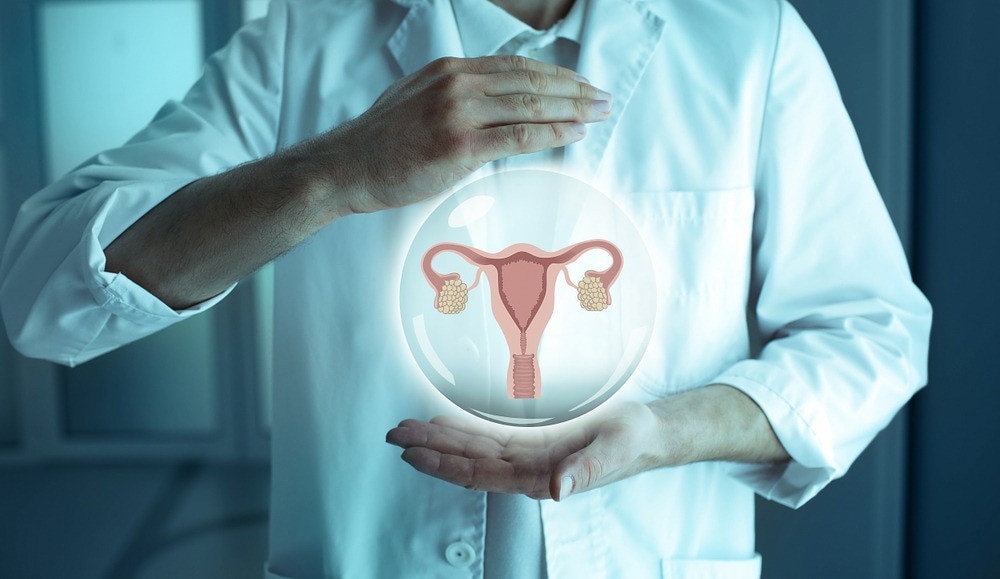Reviewed by Danielle Ellis, B.Sc.Aug 14 2023
Researchers have developed a synthetic extracellular matrix (ECM) that can facilitate the development of a miniature endometrium in a dish for at least two weeks. The mucosal lining of the uterus, the endometrium, has historically been challenging to model in the laboratory, which has restricted scientists’ ability to investigate its function in both healthy and diseased states like endometriosis.

Image Credit: Peakstock/Shutterstock.com
Scientists may be better able to simulate both the healthy and pathological response to menstrual cycles thanks to the matrix, which was described on August 11th, 2023, in the journal Med. The matrix allows cells to interact in a setting that recapitulates human physiology.
With this matrix, we can begin to extrapolate and utilize samples from patients that have been diagnosed with certain reproductive diseases. We can begin to explore how organoids grown from patients’ cells are behaving differently than those of healthy individuals.”
Juan Gnecco, Study First Author, Tufts University
To date, researchers have been growing organoids (mini organs in a petri dish) using Matrigel, a naturally derived hydrogel. Despite providing some support for organoid growth, Matrigel contains proteins that can disrupt cell-cell communication.
This is especially important when modeling the endometrium, which is made up primarily of epithelial glands and stromal cells, and their crosstalk influences how the endometrial tissue changes during the menstrual cycle as a result of sex hormones.
“If the stromal cells try to talk to the epithelial cell, it’s like trying to talk to your friend if you're standing on the runway at the airport at rush hour,” notes senior author Linda Griffith of the Massachusetts Institute of Technology about endometrium organoids co-cultured with stroma in Matrigel.
Griffith, Gnecco, and their colleagues created a synthetic ECM out of hydrogel and a small number of biological signals. The researchers then co-cultured endometrial stromal and epithelial organoids from human donors in a synthetic matrix, and the co-culture remained intact for at least 15 days. Matrigel, on the other hand, did not support stromal cultures and had partially disintegrated and shrunk by day 15.
The synthetic ECM's design also enables cells to sequester their own matrix as they grow.
One of the things that can be different between a disease and a normal cell is that they may make slightly different sets of matrix molecules. With this ECM, we can create a microenvironment similar to what the cells are experiencing in vivo. That's something we're very excited about.”
Linda Griffith, Study Senior Author, Massachusetts Institute of Technology
To see if the matrix could encourage the growth and function of endometrial epithelial and stromal cells, the investigators treated the co-cultures with synthetic progesterone, a sex hormone that plays a significant role in the menstrual cycle, to imitate the conditions of the menstrual cycle.
The hormone thickened the organoids’ epithelial layer, enhanced the secretion of a pro-gestational protein, and induced stromal differentiation, all of which were observed in humans.
The cultures were then exposed to a type of pro-inflammatory cytokine connected to endometrial diseases in humans, including endometriosis, a condition in which endometrial tissues grow outside of the uterus. They discovered that in co-cultures containing both epithelial and stromal cells, the cytokine significantly increased epithelial cell proliferation, a feature seen in endometriosis patients. The abnormal growth was not observed in a monoculture of epithelial cells.
It really highlights that cell communication is important, not only for sex hormone signaling but even inflammatory communication between cells. There's still more about the mechanism that we need to delve into, and now there is a platform that can be used to investigate that in more detail. There's going to be a huge benefit for other studies downstream from this.”
Juan Gnecco, Study First Author, Tufts University
Source:
Journal reference:
Gnecco, J., et al. (2023). Organoid co-culture model of the human endometrium in a fully synthetic extracellular matrix enables the study of epithelial-stromal crosstalk. Med. doi.org/10.1016/j.medj.2023.07.004.